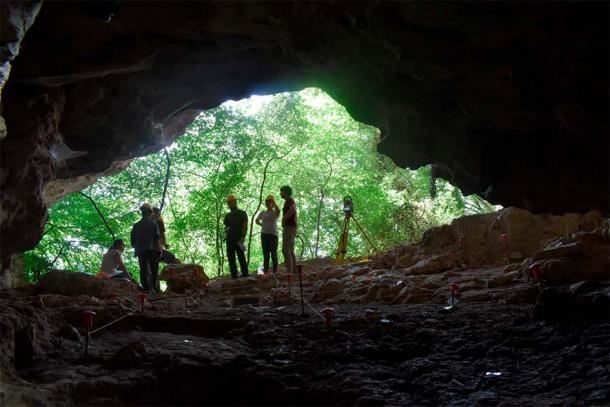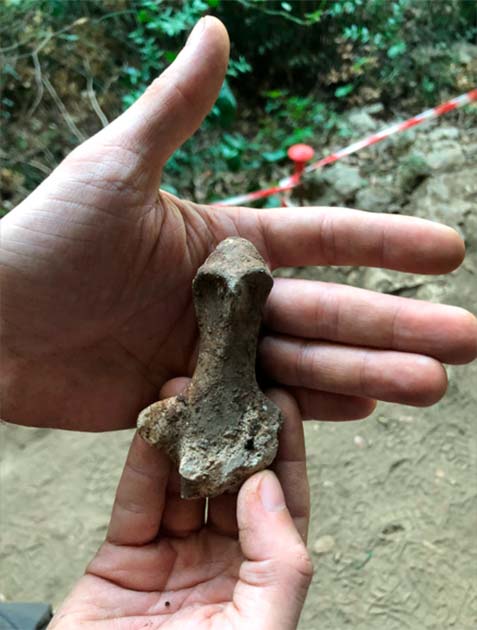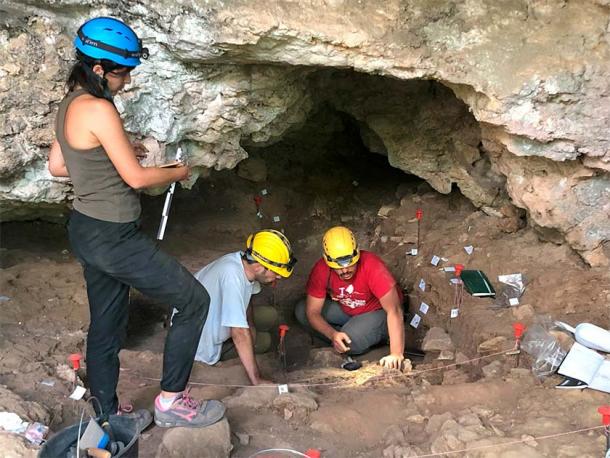
Enigmatic 7,000-year-old Figurine Found In Italian Cave Shocks Archaeologists
When archaeologists in Italy were exploring the spectacular Battifratta Cave, they did not expect to unearth “a rare” clay female figurine. And neither were they ready for the dating of the piece, which determined the artifact was created some 7,000 years ago.
The Battifratta Cave is a geological wonder located near Poggio Nativo in Sabina, Italy. Deep within a labyrinth of underground chambers and tunnels, adorned with stalactites and stalagmites, a team of archaeological explorers from the Department of Ancient Sciences of Sapienza discovered the ancient doll during their last excavation campaign.
Deemed “unique” in this region, the timeworn female doll is whispering secrets about prehistoric society, and she’s telling stories about ancient rituals and journeys in the afterlife.
- Half A Million Dollar Mask With Otherworldly Origins
- The Venus Figurines of the European Paleolithic Era

Entrance to the Battifratta Cave, Sabina, Italy. (Sapienza University of Rome)
The Waters of Life
Located at the entrance to the Battifratta Cave is an ancient spring, which archaeologists say is probably seasonal, and once served as a point of attraction for ancient communities. It was always suspected that this site was used for ritualistic purposes, and the discovery of this 7,000-year-old clay figurine ‘almost’ solidifies this suspicion.
A press release from the Sapienza University in Rome says objects of this kind are “very rare in Italy.” Furthermore, the release said such artifacts are “almost absent” in the archaeological record of the Tyrrhenian slope. Having been made during the Neolithic period, when the peninsula was inhabited by the first farming communities, it is suspected the clay doll was associated with agriculture, and possibly used in fertility rituals.
- New Kind of Neolithic Age Human Burial Ritual Found in Spanish Cave
- Elaborate Funeral Rituals and Exhumation of the Dead in Toraja Culture

7,000-year-old ‘figurine’ found in Italy. (Sapienza University of Rome)
Pinning Down the Creator
The modern research at the Battifratta Cave is part of a wider research project being conducted by the Sapienza Grand Excavations Fund, who are looking at the prehistoric settlement of the Farfa valley and its neighboring territories.
A multidisciplinary study coordinated by the Department of Ancient Sciences of Sapienza is looking at “the technological and stylistic aspects” of the figurine to better understand how it was made. The scientists are also looking for iconographic signatures to pin down the specific culture who created and used the rare female figurine.
The archaeologists said the doll’s facial features are only hinted at, in a schematic way. However, the researchers said the artisan who made the artifact showed “greater care” in representing the hairstyle and body decorations.
The Ancient Woman Suggests Burial Rituals
Dr. Cecilia Conati of Sapienza University said when the presence of ceramics is combined with faunal and botanical finds on several stratified levels, and the discovery of a human skeleton beside the doll, secrets are revealed. This all suggests the spring at the mouth of the cave was not only used for water supplies, but also for “burial and ritual purposes.” And perhaps the doll was used in these rituals?

Ongoing examinations of the cave site. (Sapienza University of Rome)
Around 7000 BC, the Battifratta Cave provided shelter and protection for early human inhabitants relying on hunting, gathering, and rudimentary agriculture for survival. While specific evidence of rituals in Battifratta Cave during the ancient period is limited, the clay doll strongly suggests it was used for ceremonial purposes.
At Valcamonica, located in northern Italy, archaeologists found rock art with depictions of animals and symbols, associated with ritualistic significance, dating to around 7,000 BC. Furthermore, at Arene Candide in Liguria, complex burials and large communal structures dating to 7,000 BC were used for ceremonial and ritual activities. So, the chances are high that this clay doll was a central piece in a prehistoric ritual, perhaps relating to agricultural and/or human fertility?
Top image: Left; Female figurine found at Battifratta Cave. Right; archaeologists investigating at the cave. Source: Sapienza University of Rome
By Ashley Cowie
















Comments
The press release from the Sapienza University of Rome who are currently studying the object says,” The facial features are mentioned in a schematic way, but more care seems to have been taken in the representation of the hairstyle and decorations of the body”. They have so far interpretted it as a female figure.
Gary
Looking at this figurine, somehow I don’t see that it’s a female. Unless your photo is too dark, or there’s another angle that shows some female traits, this item looks like an animal or bird. How did you come to the determination that it’s a female?
Hi! As always, worth questiong the ‘ritual’ nature of an object as it is used so often. The article is reporting the suggestions from the professionals who are currently studying it, who give some evidence to support the claim. The press release from the Sapienza University of Rome, who are currently studying the object states: "The presence of lithic industry ceramics, fauna and botanical finds on several layered levels – explains Cecilia Conati della Sapienza – reveals the use of the spring and the cave not only for the supply of water, but also for sepulchral and ritual purposes, as evidenced by the human skeletal remains found and the clay statuette." Apologies if this is not included in the article, I’ll take a look. Thanks for pointing it out.
Gary
I have to agree. This was all conjecture.
that could have been a child's toy.
In the article there is not a single relevant argument that the figurine is used in ritual activities. Please refrain from pure speculation or mark it as such